This is one of the three largest caves in the prefecture of Heraklion. It lies at half an hour distance to the north-west from the village of
Skotino and is at a height of 225 m. above sea-level.
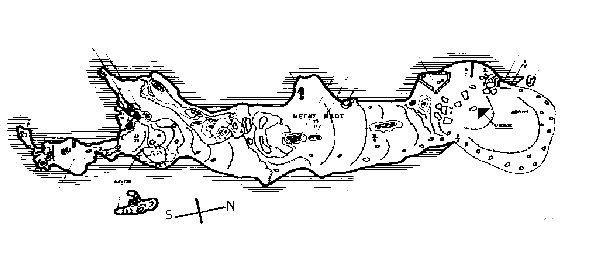
The entrance to the cave is impressive: a large arch, 27 m wide and 10 m high. To the right one can see the ruins of an ancient chapel on which the modern chapel dedicated to Aghia Paraskevi was built. There is a feast held in front of the chapel on July 26th .

the entrance
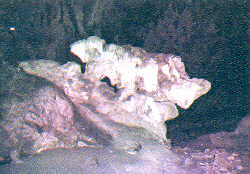
the bear
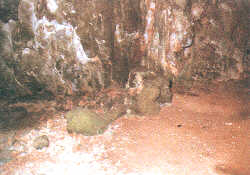
the dog
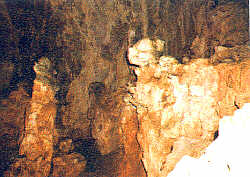
"a woman's and a child's head"
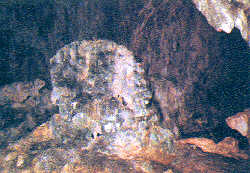
"a head"
A path goes down from the entrance and leads to a large and imposing chamber called "Mega Nao", 130 m long, 33 m wide and 30 m high. It includes a vast number of stalagmites. Deeper into the cave and to the right there is an impressive collection of stalactites, some reaching the floor.
Different shapes can be made out: the head of a woman, a smiling child, a lying dog, a bear. Finally, further downhill, there is a smaller chamber, known as the altar where sacrifices were carried out, 24 m long, 8.5 m wide and 25 m high.
Drains on the surface of the floor were used most certainly for libations and offerings to the god of the underworld (blood, oil, wine and so on).
To the left of the first chamber, the "Adyton" measures 15 x 8 x 2.3 m, and leads to another entrance to the cave. The most spectacular chamber, known as the "Adoration Hall", between the Altar and the "Adyton", lies 50 m underneath the level of the entrance, is vaulted and measures 12 x 12.5 x 10-15 m. A large corridor, 12 m long and 2 m wide, leads to this chamber which, in winter, is flooded up to one third of its height.
Higher up, the "Praying Room" is smaller (7.5 x 5 m) and has a large number of stalactites and stalagmites forming columns that give this chamber a particular charm. You can read a great many names that have been inscribed on the walls of the cave through the years. Finally, a small space, known locally as "the little chapel", is 12.5 m long and 1.5 to 5 m wide.
The length of the visit is 450 metres and the overall surface of the cave is over 2500 square metres. It goes without saying that this impressive cave is a great tourist attraction and is well worth a visit.
Excavations have been carried out in the Aghia Paraskevi cave. In 1933, Evans and Pendlebury proceeded to the first excavations. P. Faure followed suit in 1953 and, more recently, in 1962, the archaeologist Davaras. The archaeological finds indicate that the cave was - and is - a sanctuary over a very long period, i.e. since the middle Minoan years (1900 BC) to Roman times. It was then turned into a Christian sanctuary and continues to function as such.
From several offerings that have been found in the cave and certain indications on the columns of the stalactites and stalagmites, it seems the cave was at one period dedicated to the goddess Britomartis.
Paul Faure, after a prolonged study, came to the conclusion that this cave is actually the famous labyrinth of Knossos.